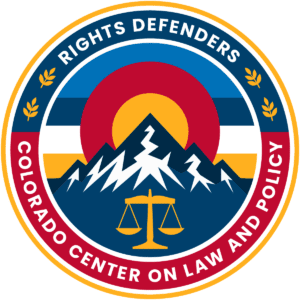Advocates celebrate bipartisan approval of bill to assess language access practices at state agencies
Recent articles
CCLP rallies in support of the CFPB
Charles Brennan joined partner organizations and leaders in Greeley, Colorado for a pro-Consumer Financial Protection Bureau rally.
CCLP testifies in support of prohibiting surveillance data to set prices and wages
Charles Brennan provided testimony in support of House Bill 25-1264, Prohibit Surveillance Data to Set Prices and Wages. CCLP is in support of HB25-1264, as it is one of our priority bills.
Press Release: Colorado Lawmakers Signal Ongoing Commitment to Tackling Algorithmic Exploitation
Landmark Debate on HB25-1264 Marks Critical Step in Taking on Surveillance Pricing and Discriminatory Wages
New Public Charge rule takes effect December 23

Some immigrants who apply for a green card or a visa to enter the United States must pass what’s called a “public charge” test. The test is designed to evaluate whether the person will primarily depend on the government for support in the future, based on factors such as the individual’s income, employment, and past use of certain public benefits.
On December 23, 2022, a new public charge rule goes into effect. The rule is hailed as a victory for immigrant communities. The new rule was finalized by the Biden Administration in September and replaces the longstanding public charge policy known as the 1999 Field Guidance.
The new public charge rule includes multiple wins for immigrants. The rule affirms that many immigrants are exempt from the public charge test. The rule also clarifies what is and is not considered in the public charge test, reaffirming that most public benefit use does not affect one’s chance of getting a green card or a visa. Finally, while U.S. public charge policies could change in the future, by putting these policies in rule, the Biden Administration has made it more difficult for future presidents to radically change public charge policy in a way that harms immigrant families.
Here are three things you need to know about public charge, adapted from the Protecting Immigrant Families Coalition.
1. The public charge test does NOT apply to all immigrants.
Many immigrants are exempt from the public charge test. The public charge test does not apply to humanitarian immigrants, including refugees; asylees; survivors of domestic violence, trafficking, and other serious crimes; special immigrant juveniles; and certain individuals paroled into the U.S. The public charge test also does not apply to green card holders (a.k.a. legal permanent residents) who are renewing their green card or applying to become a U.S. citizen, unless they are planning to leave the country for more than 6 months, in which case they should speak with an immigration attorney. (For a complete list of immigrants who are exempted from public charge, see 87 Fed. Reg. 55637-9.)
2. Many public benefits are NOT considered in the public charge test.
There are only two types of government programs that are considered in a public charge test:
- Public cash assistance for income maintenance, which is regular cash support that is intended to support someone, like Supplemental Security Income (SSI), Colorado Works/Temporary Assistance for Needy Families (TANF), and Old Age Pension (OAP). (Tax credits and supplemental or “special purpose” payments, like payments for child care, energy assistance, disaster relief, or pandemic assistance, are not)
- Long-term institutional care, like nursing home care that is paid for by Medicaid. (Home- and community-based services, short-term rehabilitative care, and incarceration are not)
All other public benefits are NOT considered in a public charge test, including:
- Health coverage (except for long-term institutional care), such as Medicaid, Emergency Medicaid, Child Health Plan Plus (CHP+), and insurance and subsidies through Connect for Health Colorado and OmniSalud.
- Food and nutrition programs, such as the Supplemental Nutrition Assistance Program (SNAP), the Special Supplemental Nutrition Program for Women, Infants, and Children (WIC), school lunch programs, and food banks.
- Housing programs, such as Section 8 and public housing.
- COVID-19 vaccines, testing, and treatment, and COVID-related supports, such as Pandemic Electronic Benefits Transfer (P-EBT), stimulus payments, child tax credits, and emergency rental assistance.
- Cash benefits based on work or earnings, such as Social Security, retirement, pensions, veterans benefits.
Additionally, the new rule makes it clear that only benefits used by the applicant will be considered in a public charge test; benefits received by a household member, such as an applicant’s U.S.-citizen child, will not be considered.
It’s also worth noting that most immigrants who are subject to the public charge test are not eligible for most of the benefits that are considered in the test. For example, at this time, undocumented immigrants, including Deferred Action for Childhood Arrivals (DACA) recipients, are not eligible for SSI, Colorado Works/TANF, or regular Medicaid.
Finally, even if someone is subject to public charge and has received one of the types of public benefits that may be considered in the public charge test, they may still be able to pass the public charge test. Immigration officials are required to look at all of an applicant’s circumstances, including not only past use of public benefits, but also one’s income, employment, education, health, family status, and affidavit of support from a sponsor. Past use of public benefits can therefore be outweighed by positive factors.
3. We need to close the information gap.
While Trump-era public charge policies have been reversed and are no longer in effect, the chilling effect on immigrant communities continues, with many immigrants reluctant to access services available to them out of fear that doing so may jeopardize their immigration status.
Spreading accurate information about public charge is critical to ensuring that community members are able to make well-informed decisions and access the services and supports for which they’re eligible.
Want to spread the word in your community?
Find public charge resources for community members in nine different languages at https://pifcoalition.org/publiccharge2022, including:
- Does Public Charge Apply to Me?
- Public Charge: 3 Things You Need to Know
- The 1,2,3s of Public Charge
Find public charge resources for advocates at https://pifcoalition.org/public-charge-advocates-resources, including:
- Public Charge: What Advocates Need to Know
- The Biden Public Charge Regulation: What Does it Mean for Immigrant Families?
The information provided in this article does not, and is not intended to, constitute legal advice and instead is for general informational purposes only. Though CCLP makes an effort to update information on this website with legal changes, the information here may not constitute the most up-to-date legal or other information. This article was published on December 22, 2022, adapted from an article originally published on CCLP’s website on October 6, 2022.

